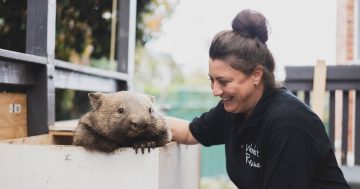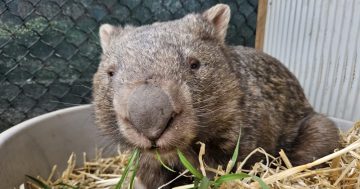
Founder and president of ACT Wombat Rescue Yolandi Vermaak, right, shows some of the orphan babies to the Czech First Lady, Eva Pavlová at the new enclosure at Ginninderry. Photo: Michelle Kroll.
Prague and Canberra may be on the opposite sides of the world, but when it comes to protecting native wildlife – particularly wombats – the two couldn’t be closer.
Described as an international first, a wombat enclosure has been established at Ginninderry on its Belconnen Farmhouse precinct, a joint initiative between Wombat Support & Rescue NSW/ACT, the Ginninderry Conservation Trust and Prague Zoo.
It was officially opened on Wednesday, 27 November by the First Lady of the Czech Republic, Eva Pavlová, on behalf of President of the Czech Republic Petr Pavel and Prague Zoo.
For Yolandi Vermaak, founder and president of the Canberra wombat rescue group, it marked the most special of days.
So how did it happen?
“One of our wombat rescue volunteers works at the Czech embassy,” Yolandi said. “He introduced me to some people there … and you know how these things happen.
“They knew about wombats because they have Cooper. He came from Tasmania and is in the Prague zoo. They’ve also introduced a female and hope they have babies. So they are already invested in our wildlife.”
Yolandi said the new 15-metre by 15-metre wombat enclosure at Ginninderry was funded by Prague Zoo after talks between the Embassy of the Czech Republic in Canberra and the zoo’s director.
“This enclosure is a symbol of what we can achieve when people and organisations unite for a common cause,” she said.
“It offers a safe haven for wombats in need and reflects the growing awareness and commitment to preserving this iconic species.
“We are incredibly grateful to the Prague Zoo, the Ginninderry Conservation Trust, and everyone who has supported our work.”
She said the enclosure, with two burrows already dug, would be a safe haven for two wombats prior to their release into the wild.
“It is very important for us to have this space,” she said. “Our volunteers are running out of room at their places.”

Caring for newborn wombats is a constant round of observation and feeding but the dedicated ACT Wombat Rescue volunteers wouldn’t have it any other way. Photo: Michelle Kroll.
Yolandi said the Ginninderry sanctuary was crucial for the wellbeing of the growing number of wombats coming into care.
She said wombats could survive for up to 30 years in captivity or 10 years in the wild, but faced constant threats to their survival – with their main predator being humans.
Much of the volunteers’ rescue work involves the heart-breaking task of checking the pouches of wombats, which have been killed by cars, to see if any babies have survived.
Once rescued, the babies need constant care and observation, feeding every few hours and a warm pouch to sleep in.

Maggie the wombat gets up close and personal with Tyson Powell from the Ginninderry team after the enclosure was opened this week. Photo: Michelle Kroll.
CEO of the Ginninderry Conservation Trust, Dr Jason Cummings, said the rescue group already played a vital role in mapping the population of wombats across the Ginninderry Conservation Corridor, identifying 25-40 wombats and more than 100 burrows in the area. The proposed 596-hectare conservation corridor connects Ginninderry to the surrounding Murrumbidgee River and Ginninderra Creek.
“This project is a testament to what can be achieved when local expertise, international collaboration and community stewardship come together,” Dr Cummings said.
“It not only highlights the importance of the Ginninderry Conservation Corridor but also strengthens our commitment to the protection, enhancement and appreciation of the cultural and environmental values of the area.”



















